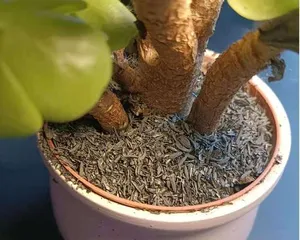Succulents are a type of very lovely plant, and many people enjoy growing them. However, for succulents to grow healthily, they not only require a suitable environment and water but also proper nutrition. Today, I want to introduce a substance that can be used to provide nutrition for succulents—plant ash.

What is Plant Ash?
Plant ash refers to the ash produced after burning materials such as wood and plant straw. Plant ash contains a large amount of mineral elements like potassium, calcium, and magnesium, which can provide essential nutrition for plants.
The Role of Plant Ash
The elements in plant ash, such as potassium, calcium, and magnesium, can neutralize soil acidity, regulate soil pH, and also promote plant growth and enhance disease resistance.

Choosing the Right Plant Ash
On the market, there are many different brands of plant ash. When choosing plant ash, you should pay attention to checking the manufacturer and production date, and try to select fresh products from reputable manufacturers.
How to Use Plant Ash
Mix plant ash with dry sand at a ratio of 1:2, then sprinkle it evenly on the surface of the potting soil. Plant ash should not be applied directly to the plant's root system, as it will burn the plant.
When to Apply Plant Ash
Plant ash can be applied at any stage of the plant's growth period, but it is best to do so during the vigorous growth phase.

Amount of Plant Ash to Use
For succulents, the amount of plant ash used per application should be controlled to within about 15 grams per liter of potting soil.
Precautions for Using Plant Ash
1. Plant ash should not be mixed with nitrogen fertilizer, as it will affect the plant's absorption efficiency.
2. Plant ash should not be used in excess, otherwise it will burn the plant's roots.
3. When using plant ash, pay attention to maintaining appropriate moisture in the potting soil.
4. Water promptly after fertilizing to help the plant ash dissolve and penetrate deep into the potting soil.
Nutritional Needs of Succulents
Succulents have relatively low nutritional needs and do not require excessive fertilization. Over-fertilization can actually harm the plant.
Using Plant Ash with Other Fertilizers
Plant ash can be mixed with well-rotted organic fertilizer, phosphate fertilizer, trace element fertilizers, etc., to achieve better fertilization results.
How to Store Plant Ash
Plant ash should be stored in a dry, ventilated place to avoid moisture and deterioration.
Effects of Using Plant Ash
After fertilizing with plant ash, succulents will become healthier and their colors more vibrant. At the same time, plant ash can also promote flowering in succulents.
The Difference Between Plant Ash and Baking Soda
Some people might confuse plant ash with baking soda. In fact, although both are white powdery substances, their composition and methods of use are different. Plant ash is rich in elements like potassium, calcium, and magnesium, and is mainly used to provide plant nutrition; whereas baking soda contains sodium bicarbonate and is primarily used to adjust soil pH.
Substitutes for Plant Ash
If plant ash is unavailable, charcoal ash or lime powder can be used as substitutes. However, when using them, attention should be paid to controlling the amount to avoid over-fertilization.
Key Points for Using Plant Ash
Plant ash should be sprinkled evenly on the surface of the potting soil, avoiding direct contact with the plant's root system. At the same time, when fertilizing, pay attention to the amount and timing of the plant ash application.
Plant ash is a substance that can provide nutrition for succulents, and regular use can help them grow healthier. However, when using plant ash, attention should be paid to its methods and precautions to avoid harming the plants.